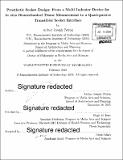Prosthetic socket design : from a multi-indenter device for in vivo biomechanical tissue measurement to a quasi-passive transtibial socket interface
Author(s)
Petron, Arthur J
DownloadFull printable version (31.61Mb)
Alternative title
From a multi-indenter device for in vivo biomechanical tissue measurement to a quasi-passive transtibial socket interface
Other Contributors
Program in Media Arts and Sciences (Massachusetts Institute of Technology)
Advisor
Hugh M. Herr.
Terms of use
Metadata
Show full item recordAbstract
The prosthetic socket, the mechanical interface between an amputated residuum and an external prosthesis, is of critical importance to the performance of a prosthetic limb system. Conventional prosthetic socket technology is derived using a non-quantitative, artisan methodology. Consequently, a comfortable socket interface cannot be made reproducibly, and persons with limb amputation too often experience discomfort. As a resolution to this difficulty, the field of digital prosthetic socket design seeks to advance a quantitative CAD/CAM methodology for socket production to produce reproducible and comfortable interfaces. Prosthetic researchers have proposed a digital socket production work flow comprising the steps of 1) assessment of residuum tissue biomechanics; 2) modeling optimization of the residuum-socket interface, and 3) fabrication of a variable-impedance socket system based upon these optimizations. In this thesis, two novel technologies are designed, built and evaluated at either end of this work flow, namely a multi-indenter device for in vivo biomechanical tissue measurement and a quasi-passive variable-impedance transtibial socket interface. An active indenter platform called the FitSocket is presented. To assess residual-limb tissue biomechanics, the FitSocket comprised 14 position and force controllable actuators that circumferentially surround a biological residuum to form an actuator ring. Each actuator is individually controllable in position (97.1?m accuracy) and force (330mN accuracy) at a PC controller feedback rate of 500Hz, allowing for a range of measurement across a residuum. At five distinct anatomical locations across the residual limb, force versus deflection data are presented, demonstrating the accuracy and versatility of the FitSocket for residual limb tissue characterization. A passive, single indenter version of the FitSocket, called the FitPen, is also presented. The FitPen is designed to be ultra-portable in order to take biomechanical measurements in the field outside the laboratory setting. A quasi-passive socket (QPS) is presented having spatially and temporally varying socket wall impedances. The QPS is an autonomous computerized transtibial prosthetic interface that can stiffen or become compliant using computer-controlled electrolaminate actuators. The QPS measures forces applied by the limb on the socket, 3-axis acceleration of the socket, and the position of the electrolaminates. On a test participant with transtibial amputation, the socket was evaluated through sit-to-stand tests to determine the viability of computer-controlled electrolaminate engagement, and through a walking study to evaluate the ability of the electrolaminates to maintain their clutched state during ambulation at a self-selected walking speed. The average deflections of forced tibia movement in the sit-to-stand tests were 7 ± 2 mm while sitting with the electrolaminates in an unclutched state, and 2.1 ± 0.6 mm while standing with the electrolaminates in a clutched state. Further, the walking study showed a maximum unclutched deflection (3.7 ± 0.9 mm)16 times larger than that of the maximum deflection while clutched. This work was supported by the United States Department of Veteran Affairs through the VA Innovation Initiative (VAi2) program.
Description
Thesis: Ph. D., Massachusetts Institute of Technology, School of Architecture and Planning, Program in Media Arts and Sciences, 2016. Cataloged from PDF version of thesis. Includes bibliographical references (pages 183-197).
Date issued
2016Department
Program in Media Arts and Sciences (Massachusetts Institute of Technology)Publisher
Massachusetts Institute of Technology
Keywords
Program in Media Arts and Sciences ()